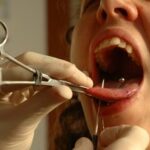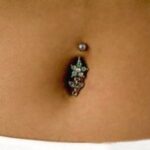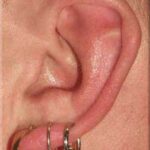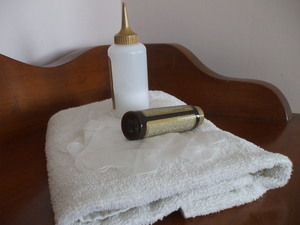I like to collect things. I have a decent collection of books. I collect pens that I pick up in the doctor’s office. I collect toys. Yet I have one collection I can take with me anywhere and it’s the one that has cost me the most money. It is my collection of ear piercings. I have quite a few and I always say that if I want to lose five pounds all I would have to do is remove my earrings. After seeing an ear piercing that was not in the lobe or restricted to that sweet spot on the upper cartilage, I decided I should spend my life (and money) getting as many of the different ear piercings I could (pain threshold and ear space allowing). You’re probably wondering how many different ear piercings there could possibly be given that the ear is such a small surface. There are plenty of different ear piercings to get if you’re just looking to add to your piercings or if you’re looking for something that isn’t seen everyday. I’ll also tell you the easiest way to take care of any ear piercing.
The Industrial
The industrial piercing is easily defined by two piercings joined together by a long or short barbell. The most popular of the industrial piercings is the helix to helix industrial. There is one hole pierced at the helix (the ridge of your ear) towards the bottom where the lobe meets the cartilage and then another hole pierced farther up the helix. Then a barbell is put in place instead two rings. This gives the appearance that there is a bar running across the span of your ear. Now there are many variations on the industrial piercing- the other most often seen is the one done through the conch (the part that holds your ear to your head, shaped like a shallow bowl) that is quite a conversation starter. At one time, many piercers would not do the industrial piercing but now many are coming up with different ways to use the large barbell to connect two parts of your ear.
The Orbital
This one is much like the Industrial piercing, except a ring is used instead of a barbell. This gives the appearance of a ring orbiting around a part of your ear, much like the rings of a planet. An orbital can be done with your already existing lobe piercings by threading a ring through two of the separate holes. Most people get them done on the flat part of the upper ear where there is more cartilage, but piercers are also coming up with many creative ways to do the orbital piercing.
The Rook
The rook is an ear piercing best suited to those with a high pain threshold. This one hurts. The rook is in the upper part of your ear, identified as the edge of where your conch folds to the flat surface and where the helix starts on the inside of your ear. Basically, it is the ridge on the inner part of your ear that is not connected to the helix. Some people have more defined rooks than others, and a piercer will take this into consideration before doing the piercing. The rook piercing is usually done in a smaller gauge to make going through the large piece of cartilage there easier and you have the choice of putting a ring or a tiny barbell in as your piece of jewelry. Unlike the industrial or orbital piercings, the rook is small and can easily be hidden if needed.
The Conch
The conch is the inner most part of your ear that is shaped like a bowl (or shell). It is a thick piece of cartilage that many people pierce. Some people like to get the conch industrial that is described above that is also called the “scaffold” piercing, due to the appearance that the barbell is holding your ear up. Yet most of the conch piercings are just one hole with either a large ring or a barbell. In my opinion, the conch is the easiest piercing to get with the easiest aftercare.
The Tragus
The tragus is the tiny, tiny part of your ear that slightly covers the hole leading to your ear canal. Some piercers won’t attempt the tragus piercing if they think your tragus is too small. I was denied having my tragus done. But this piercing is also tiny, and from what my sister has told me, very painful. The tragus can either be adorned with a ring or a barbell after wards. Some people also claim that once they had the tragus on both of their ears pierced, they never suffered through another migraine. If you’re considering a tragus you may have to give up your iPod for the healing period- ear bud headphones are known to give tragus piercings a painful infection.
The Daith
The daith is right below your rook, where the helix of your ear connects to your conch. This is another tiny piercing that usually seen with a ring. This is also another piercing I was not able to have done, my daith was a tad too tiny. But if your daith is prominent, you’ll be able to have the piercing done.
Those are just a few of the examples of different ear piercings. Many piercers are coming up with new and daring ways to pierce ears by using the various parts of the ear and the new types of jewelry available.
After you have an ear piercing done, there is still the aftercare. Many people are split on aftercare; some will spend money on “specially formulated” solutions or use the old bottles given to them when they had their earlobes pierced. Here is an aftercare solution that I have used on all of my ear piercings and it has not failed me yet.
For the aftercare solution you’ll need a spray bottle. Fill the bottle with warm water and a pinch or two of sea salt. Then shake the bottle to mix and you’re done! You can spray the sea salt solution on as needed and put it on a cotton ball to get the hard to reach parts of the piercing. I also like to buy a bottle of anti-bacterial soap to use on my new piercing in the shower- anything with fragrance can irritate the piercing, including shampoo and hair products.
Sea salt and anti-bacterial soap is the easiest way to care for a piercing and will keep your piercing clear of infection or keloids. Just remember to use sea salt and not regular table salt, that will cause your piercing to bleed. Don’t use peroxide on the piercing. Don’t try to move the piercing too soon, you don’t want to break the scab that formed- it will just be harder to heal the piercing. Just let the sea salt soak the piercing and do its work! Use a new pillowcase when you get a new piercing to reduce the likelihood of infection. My number one tip for aftercare: Watch out when you brush your hair. A brush caught in a new piercing is no fun.
And, of course, enjoy your new and different ear piercing.
Source:
http://www.bme.com/pierce/01-ear/bme-pg01.html




